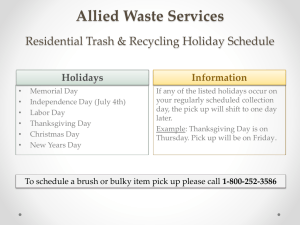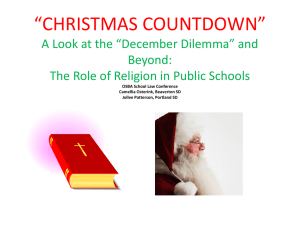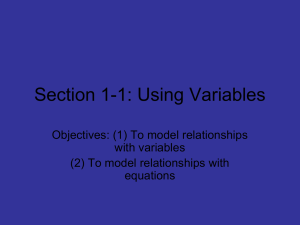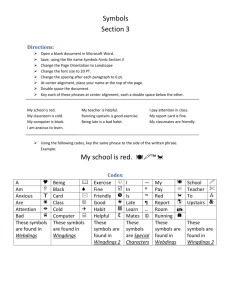Grade: K Unit: 4 Title: America: Symbols and Celebrations Dates of
advertisement
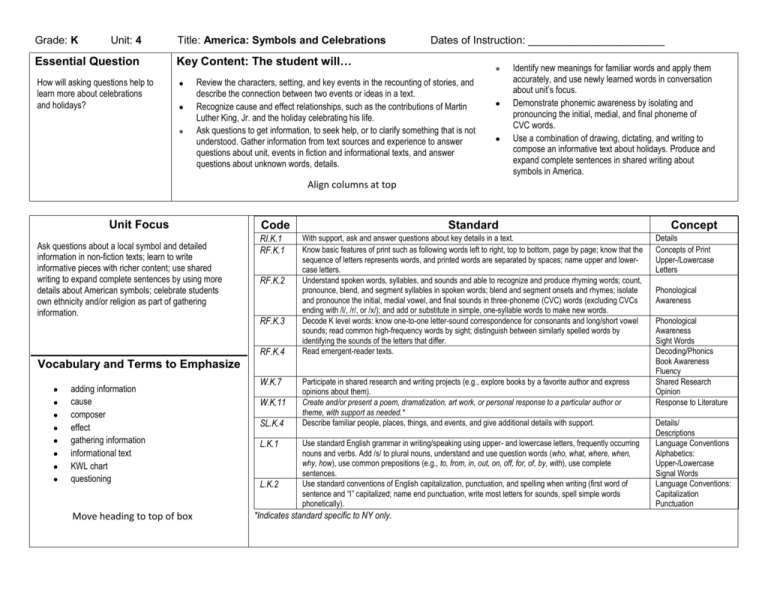
Grade: K Unit: 4 Title: America: Symbols and Celebrations Essential Question Key Content: The student will… How will asking questions help to learn more about celebrations and holidays? Dates of Instruction: _______________________ Review the characters, setting, and key events in the recounting of stories, and describe the connection between two events or ideas in a text. Recognize cause and effect relationships, such as the contributions of Martin Luther King, Jr. and the holiday celebrating his life. Ask questions to get information, to seek help, or to clarify something that is not understood. Gather information from text sources and experience to answer questions about unit, events in fiction and informational texts, and answer questions about unknown words, details. Identify new meanings for familiar words and apply them accurately, and use newly learned words in conversation about unit’s focus. Demonstrate phonemic awareness by isolating and pronouncing the initial, medial, and final phoneme of CVC words. Use a combination of drawing, dictating, and writing to compose an informative text about holidays. Produce and expand complete sentences in shared writing about symbols in America. Align columns at top Unit Focus Ask questions about a local symbol and detailed information in non-fiction texts; learn to write informative pieces with richer content; use shared writing to expand complete sentences by using more details about American symbols; celebrate students own ethnicity and/or religion as part of gathering information. Code RI.K.1 RF.K.1 RF.K.2 RF.K.3 RF.K.4 Standard With support, ask and answer questions about key details in a text. Know basic features of print such as following words left to right, top to bottom, page by page; know that the sequence of letters represents words, and printed words are separated by spaces; name upper and lowercase letters. Understand spoken words, syllables, and sounds and able to recognize and produce rhyming words; count, pronounce, blend, and segment syllables in spoken words; blend and segment onsets and rhymes; isolate and pronounce the initial, medial vowel, and final sounds in three-phoneme (CVC) words (excluding CVCs ending with /l/, /r/, or /x/); and add or substitute in simple, one-syllable words to make new words. Decode K level words: know one-to-one letter-sound correspondence for consonants and long/short vowel sounds; read common high-frequency words by sight; distinguish between similarly spelled words by identifying the sounds of the letters that differ. Read emergent-reader texts. Vocabulary and Terms to Emphasize adding information cause composer effect gathering information informational text KWL chart questioning Move heading to top of box W.K.7 W.K.11 SL.K.4 L.K.1 L.K.2 Participate in shared research and writing projects (e.g., explore books by a favorite author and express opinions about them). Create and/or present a poem, dramatization, art work, or personal response to a particular author or theme, with support as needed.* Describe familiar people, places, things, and events, and give additional details with support. Use standard English grammar in writing/speaking using upper- and lowercase letters, frequently occurring nouns and verbs. Add /s/ to plural nouns, understand and use question words (who, what, where, when, why, how), use common prepositions (e.g., to, from, in, out, on, off, for, of, by, with), use complete sentences. Use standard conventions of English capitalization, punctuation, and spelling when writing (first word of sentence and “I” capitalized; name end punctuation, write most letters for sounds, spell simple words phonetically). *Indicates standard specific to NY only. Concept Details Concepts of Print Upper-/Lowercase Letters Phonological Awareness Phonological Awareness Sight Words Decoding/Phonics Book Awareness Fluency Shared Research Opinion Response to Literature Details/ Descriptions Language Conventions Alphabetics: Upper-/Lowercase Signal Words Language Conventions: Capitalization Punctuation Grade: K Unit: 4 Title: America: Symbols and Celebrations Dates of Instruction: _______________________ Suggested Activities/Investigations/Demos: 1. 2. 3. 4. 5. 6. 7. DISCUSSION/VOCABULARY/WRITING: Introduce the concept of a symbol to the students by showing them pictures of team logos, mascots, advertising logos, etc. (You might even show McDonald’s “golden arches” in different countries and explain how some symbols are universal, that knowledge of the language is unnecessary (see References). Discuss why a symbol is important for unifying fans or brand recognition. Ask how symbols can be used to inspire people. Use a theme-related short sentence to begin the unit, such as “The flag waves.” Using a basic web graphic organizer, have students think of details that can be added. Use the details to create interesting sentences (e.g., “The red, white, and blue flag waves”; “The red, white, and blue American flag waves in the strong winds of March”). READING/INFORMATIONAL TEXT: Create a KWL chart for American symbols and holidays to set the stage for asking questions, answering questions, and gathering information about symbols and holidays (reinforcing who, what, when, where, why, and how questions). Model the questioning until the students begin to generate their own questions. Using shared reading, read an informational book such as The Liberty Bell (Lloyd G. Douglas), and ask students to listen for information about the symbols. Use a think aloud to model questioning while reading and while showing the illustrations to gain information. Add the information to the KWL chart. Look for connections between ideas as you add information to the charts. Have students volunteer information to add to the KWL chart or add information to white boards. Draw attention to words and have students isolate and pronounce sounds as they practice reading CVC words. READING/INFORMATIONAL TEXT: Read a book about Martin Luther King, Jr., a president, or a holiday as a direct result of an event. Discuss cause/effect and as students listen to the story, look for cause/effect relationships (e.g., Martin Luther King Day and his life; fighting for independence and celebrating Fourth of July, etc.). Using a cause/effect graphic organizer, have students help fill in information based on what was read. WRITING/INFORMATIVE: Let the students choose one of the symbols or holidays on the KWL chart and write a complete sentence or two about it, using the information they learned, and then illustrate their sentence. Remind students about using capitals to start a sentence and proper punctuation to end the sentence. DISCUSSION/READING/LITERATURE/POETRY: Read a book, using shared reading, with viewpoints of an American holiday such as Apple Pie 4th of July (Janet S. Wong). While reading the book, ask students how the main character sees the traditional American holiday. Remind the students to look closely at the illustrations as well. Compare information with information learned through informational texts and draw connections. When you are finished reading, discuss how people see holidays and celebrations differently depending on their family, religious, and ethnic experiences. Perhaps choose to read poems about holidays, symbols, and celebrations (see Resources). DISCUSSION/SHARED RESEARCH: As an additional component to this unit, ask parents to send a photograph of their child taken during a celebration along with a note naming the celebration and what makes it special. Use this information to create a display of the student’s celebrations in preparation for this research project. Choose a holiday celebrated in your community, preferably one that is also represented in the pictures brought in by the students. Gather information about the holiday by reading books and interviewing people in the community (this could include other teachers and workers at the school, parents, or guest speakers) to tell why it is celebrated, when it is celebrated, who celebrates, and how it is celebrated. Have students create illustrations about what they have learned and display them, or create a large cube for the holiday and attach the illustrations to each side of the cube, based on the questions asked. Continue to add to the KWL chart created earlier, with new information about holidays, symbols, and celebrations. Students can create additional pictures, extending this activity for multiple holidays celebrated by the students, or write sentences about the holidays. LANGUAGE/VOCABULARY/MUSIC: Explain how some words have more than one meaning, even when they are spelled the same way and sound the same. Use the word “march” as an example. Listen to John Philip Sousa’s music (or similar music that can be marched to) and “march” around the room. Explain that “march” can be an action word, as in this case, however it is also the name of this type of song, because you want to march to it. It is also the name of a month. Say, “You can march to a march played in the month of March” and all three uses of the word have different meanings. This activity can be repeated with the word “flag,” using the word as a verb and as a noun. As words are introduced, create a word bank using index cards to collect new words from this unit. Practice using the words in discussion and making them plural (e.g., flag/flags). Strategies Graphic Organizer: Web Graphic Organizer: KWL Chart Shared Reading Think Aloud/Questioning Graphic Organizer: Cause/Effect Graphic Organizer: KWL Chart Shared Reading Graphic Organizer: KWL Chart Vocabulary Word Cards Grade: K Unit: 4 Title: America: Symbols and Celebrations Dates of Instruction: _______________________ Cross-curricular Connections Resources Religion/ Values: Discuss Christian holidays and the symbols used to represent the holidays (e.g., manger, crucifix, baptism, etc.). Art links www.art.com – type team logos, or common businesses, such as McDonalds, or any symbol in the search box. Searching McDonalds brings up several foreign examples. Math: Using a combination of geometric shapes, create symbols (i.e., rectangle and small triangles for a manger; two rectangles for a cross, etc.), and/or addition, equal, subtraction, fraction marks. Poetry www.poemhunter.com – Type holiday names or symbols into search box. Social Studies: Relate to my community and neighborhood, symbols of community heritage, including parish and order. Assessing Student Understanding Students make accurate cause and effect observations and are able to give a personal account of an occurance and its the result. When writing, students use (or dictate use) accurate end of sentence punctuation and start sentences with capital letters. Students contribute to class discussions about celebrations, holidays, and symbols by asking/answering who, what, when, where, why, and how questions, and asking questions about unknown words. Students create word cards for new words learned during the unit and demonstrate understanding of at least three new words, including multiple-meaning words, and ability to use them in conversation. Students write complete sentences (for the class research project) about holidays using information gained from asking who, what, when, where, why, and how questions. Teacher Notes/Reflections

